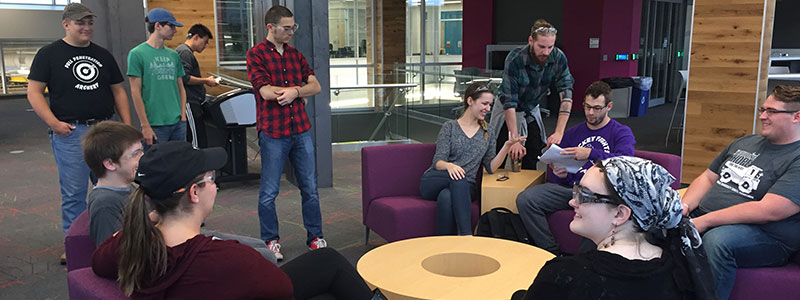
Does creativity come easier to some people than others? Perhaps, but just because creative problem solving isn’t someone’s strong suit doesn’t mean their creativity is entirely absent. Their creative abilities might just need to be coaxed out.
“Everyone can be innovative and creative,” said Nathan Mentzer, associate professor of engineering technology-teacher education (ETTE). “The challenge is unlocking our self-efficacy and confidence. Our new minor seeks to unlock that potential by increasing confidence and developing students’ creative skills.”
For students who want to improve their solution-finding abilities – and for students with more innate problem-solving capabilities – Purdue Polytechnic’s Department of Technology Leadership & Innovation has added a 300-level course to their design thinking curricula. The new minor in design and innovation is a campus-wide opportunity.
“The design and innovation minor provides a continuous pathway for students to scope problems and generate ideas,” said Greg Strimel, assistant professor of ETTE. “Students fabricate, optimize and prepare innovative technological solutions for people, from idea formation to functional prototype, ready for launching into the marketplace.”
Teaching and encouraging students to find solutions to problems isn’t new to Strimel. The “continuous pathway” he referenced refers to the core courses of TECH 12000 (Design Thinking in Technology) and TECH 22000 (Designing Technology for People), which are staples to Polytechnic students. TECH 34000 (Prototyping Technology for People) is making its debut in the fall of 2018. It is the third “stepping stone,” so to speak, of the “continuous pathway.”
“The TECH 12000 course provides a solid foundation in design thinking, and TECH 22000 teaches students how to formulate problems by understanding people and identifying opportunities for innovation,” explained Strimel. “The TECH 34000 course advances from ‘design thinking’ to ‘design action,’ and helps students move an idea to reality with the potential for impact.”
Students will validate their design concepts through multiple iterations of prototypes created in Purdue’s hands-on labs. The goal is to have students seamlessly learn from the lab instructors of Bechtel Innovation Design Center, Burton D. Morgan Center for Entrepreneurship and Wilmeth Active Learning Center while collaborating with classmates on their prototypes.
The design and innovation minor is suitable for students of all abilities and interests.
“Any student with a strong work ethic and the tenacity to accomplish a multi-year project, even through failures and various twist and turns, can succeed,” said Strimel. “In fact, success in the core design and innovation coursework heavily depends on team diversity, so students from different backgrounds and majors, with different skills, expertise and interests, are welcome in this minor to help push innovation even further.”
Real-World Lessons
The opportunity for students to visit Stockholm, Sweden, provides a global element to the minor.
“In today’s interconnected world, it is necessary to provide students with opportunities to immerse themselves in different cultures to better advance their design and global innovation capabilities,” Strimel said. “Most businesses and organizations extend beyond the borders of this country, and working effectively across culturally diverse teams is a must. Therefore, as part of the design and innovation minor, students are required to partake in an immersive cultural experience that empowers them to think globally when developing technological innovations for people. ‘Study Abroad in Stockholm’ is highlighted for this minor because Sweden is consistently considered a world leader in design and innovation.”
Creating a product from an idea all the way to a working prototype might seem daunting. What if the students’ prototypes fail? Doesn’t that result in the students’ failure as well?
“If a prototypes fails, the student team does not necessarily fail as long as they learn from the process, make changes to the concept or pivot their direction for a solution,” Strimel said. He wants students to take a big-picture approach to the minor, where failure isn’t the end of a project but is instead another lesson among countless more the students will have during their lifetimes. “This program is all about learning the journey of design and innovation—a journey that students can take with them to further their projects beyond the course or to use with other ventures as another potential career pathway for themselves.”
Additional information:
